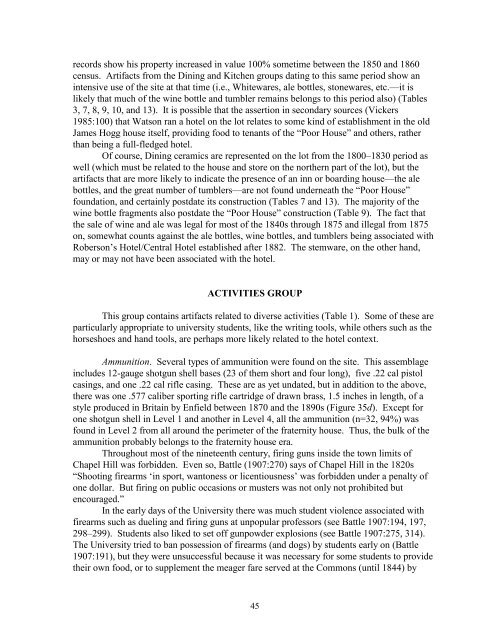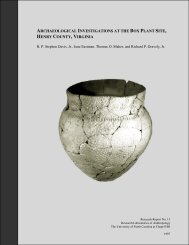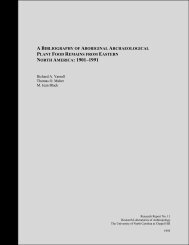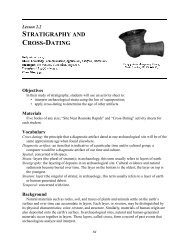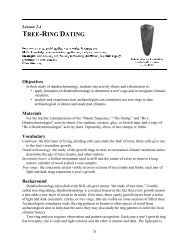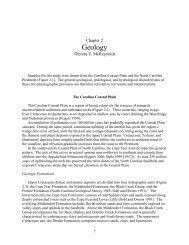during which the windows <strong>of</strong> the Tutors were shattered, stones were thrown at members <strong>of</strong>the Faculty, the University bell was rung violently and long, laboratory and recitation roomswere broken and nearly destroyed, the stables <strong>of</strong> several pr<strong>of</strong>essors entered and the horsesridden” (Battle 1907:465). It is not hard to imagine glasses getting broken at these banquets.Since the ban on selling wine in town did not go into effect until 1855, all <strong>of</strong> the aboveexamples <strong>of</strong> banquets were catered legally by Chapel Hill inn and boardinghouse proprietors.The distribution <strong>of</strong> the identified tumbler fragments is almost the same as thedistribution <strong>of</strong> the entire glass tableware assemblage (including the unidentified forms), and itis likely that a large number <strong>of</strong> the unidentified fragments are also tumbler remains. Thegreater part <strong>of</strong> the glass tableware was found in Level 2 in the southern end <strong>of</strong> the site (Table13). No fragments were found beneath the foundations <strong>of</strong> the “Poor House.” Thedistribution is very similar to that <strong>of</strong> the ale bottles.A small amount <strong>of</strong> stemware (just 5% <strong>of</strong> the assemblage – see Table 4) was identifiedfrom the glass remains <strong>of</strong> the stems and bases (seemingly dessert types <strong>of</strong> vessels – seeFigure 36b, f). Like the rest <strong>of</strong> the glass tableware, no stemware was found beneath thefoundation <strong>of</strong> the “Poor House.” The small number <strong>of</strong> fragments makes it hard to sayanything about the distribution other than they were all found in Levels 2 and 4.Metal. The identified metal belonging to the Dining group consists solely <strong>of</strong> a spoonand a spoon fragment. The one spoon from an intact context came from Level 2 in thesouthern half <strong>of</strong> the site.Summary. In summary, a good deal <strong>of</strong> eating and drinking appears to have takenplace on the site throughout the nineteenth century. Artifacts relating to dining are plentifulfrom all periods in the nineteenth century. It does not appear, however, that dining occurredin the twentieth-century fraternity house context.The Dining group assemblage is very similar to that <strong>of</strong> the Eagle Hotel (Samford1994). The same types <strong>of</strong> ceramic tablewares are found, and there is a high percentage <strong>of</strong>artifacts related to drinking—tumblers, wine bottles and ale bottles. The site <strong>of</strong> the EagleHotel (i.e., the Graham Memorial site) was a tavern, boardinghouse, or hotel for the entirenineteenth century (except for perhaps a short time while the University was closed). It isharder to explain this kind <strong>of</strong> assemblage for the Lot 11 site, since the first securelydocumented hotel, Roberson’s Hotel, was established only in the 1880s, and most <strong>of</strong> theassemblage <strong>of</strong> Dining group artifacts predates that time. It is unlikely that a great deal <strong>of</strong>cooking and dining went on in the “Poor House” rooms by students, although the smallrooms did all have fireplaces. During the 1840s, inexpensive and tasty boardinghouse fairwas so available that the University’s Commons could no longer compete, and it shut down<strong>of</strong>ficial operation in 1844 (Battle 1907:613–614). This meant that even students whoboarded in the university dorms ate at the town’s boardinghouses. Most <strong>of</strong> the male studentsand unmarried pr<strong>of</strong>essors <strong>of</strong> the time did not really have the skills to set up housekeeping forthemselves (see Battle 1907:613). The stratigraphic and spatial distribution <strong>of</strong> ceramic typesfor both Kitchen and Dining wares (i.e., the dating <strong>of</strong> those found underneath the structure,and those not) seems to indicate that the “Poor House” was built during Benton Utley’sownership, from 1832 to 1837, when historical records show improvements being made tothe lot (see Historical Background section above). Jones Watson bought the lot in 1847, and44
ecords show his property increased in value 100% sometime between the 1850 and 1860census. Artifacts from the Dining and Kitchen groups dating to this same period show anintensive use <strong>of</strong> the site at that time (i.e., Whitewares, ale bottles, stonewares, etc.—it islikely that much <strong>of</strong> the wine bottle and tumbler remains belongs to this period also) (Tables3, 7, 8, 9, 10, and 13). It is possible that the assertion in secondary sources (Vickers1985:100) that Watson ran a hotel on the lot relates to some kind <strong>of</strong> establishment in the oldJames Hogg house itself, providing food to tenants <strong>of</strong> the “Poor House” and others, ratherthan being a full-fledged hotel.Of course, Dining ceramics are represented on the lot from the 1800–1830 period aswell (which must be related to the house and store on the northern part <strong>of</strong> the lot), but theartifacts that are more likely to indicate the presence <strong>of</strong> an inn or boarding house—the alebottles, and the great number <strong>of</strong> tumblers—are not found underneath the “Poor House”foundation, and certainly postdate its construction (Tables 7 and 13). The majority <strong>of</strong> thewine bottle fragments also postdate the “Poor House” construction (Table 9). The fact thatthe sale <strong>of</strong> wine and ale was legal for most <strong>of</strong> the 1840s through 1875 and illegal from 1875on, somewhat counts against the ale bottles, wine bottles, and tumblers being associated withRoberson’s Hotel/Central Hotel established after 1882. The stemware, on the other hand,may or may not have been associated with the hotel.ACTIVITIES GROUPThis group contains artifacts related to diverse activities (Table 1). Some <strong>of</strong> these areparticularly appropriate to university students, like the writing tools, while others such as thehorseshoes and hand tools, are perhaps more likely related to the hotel context.Ammunition. Several types <strong>of</strong> ammunition were found on the site. This assemblageincludes 12-gauge shotgun shell bases (23 <strong>of</strong> them short and four long), five .22 cal pistolcasings, and one .22 cal rifle casing. These are as yet undated, but in addition to the above,there was one .577 caliber sporting rifle cartridge <strong>of</strong> drawn brass, 1.5 inches in length, <strong>of</strong> astyle produced in Britain by Enfield between 1870 and the 1890s (Figure 35d). Except forone shotgun shell in Level 1 and another in Level 4, all the ammunition (n=32, 94%) wasfound in Level 2 from all around the perimeter <strong>of</strong> the fraternity house. Thus, the bulk <strong>of</strong> theammunition probably belongs to the fraternity house era.Throughout most <strong>of</strong> the nineteenth century, firing guns inside the town limits <strong>of</strong>Chapel Hill was forbidden. Even so, Battle (1907:270) says <strong>of</strong> Chapel Hill in the 1820s“Shooting firearms ‘in sport, wantoness or licentiousness’ was forbidden under a penalty <strong>of</strong>one dollar. But firing on public occasions or musters was not only not prohibited butencouraged.”In the early days <strong>of</strong> the University there was much student violence associated withfirearms such as dueling and firing guns at unpopular pr<strong>of</strong>essors (see Battle 1907:194, 197,298–299). Students also liked to set <strong>of</strong>f gunpowder explosions (see Battle 1907:275, 314).The University tried to ban possession <strong>of</strong> firearms (and dogs) by students early on (Battle1907:191), but they were unsuccessful because it was necessary for some students to providetheir own food, or to supplement the meager fare served at the Commons (until 1844) by45
- Page 1 and 2:
ARCHAEOLOGICAL INVESTIGATIONS AT TH
- Page 3 and 4:
ABSTRACTArchaeological investigatio
- Page 5 and 6: Moffitt, Brooks Rainey, Patricia Sa
- Page 7 and 8: ChapterPage6. Conclusions and Recom
- Page 9 and 10: TablePage16. Distribution of cerami
- Page 11 and 12: FigurePage18. Excavating Sq. 140R95
- Page 13 and 14: Chapter 1INTRODUCTIONThis report de
- Page 15 and 16: Chapter 2HISTORICAL BACKGROUNDThe t
- Page 17 and 18: Book 17:59-60). Gavin Hogg paid off
- Page 19 and 20: and the sale of the western half of
- Page 21 and 22: After the Civil War, the town fell
- Page 23 and 24: train young men and women to teach
- Page 25 and 26: the university was the Delta Kappa
- Page 27 and 28: ENDNOTES1 A typescript of this deed
- Page 29 and 30: Chapter 3FIELD METHODSFieldwork was
- Page 31 and 32: Chapter 4RESULTS OF ARCHAEOLOGICAL
- Page 33 and 34: foundations were 2 ft wide and the
- Page 35 and 36: Level 2aThis soil level occurred on
- Page 37 and 38: Feature 2Feature 2 was a linear dis
- Page 39 and 40: Feature 12Feature 12 was a small, s
- Page 41 and 42: ARCHITECTURAL GROUPA large number o
- Page 43 and 44: southern and northern parts of the
- Page 45 and 46: Kitchen GroupCeramics. As shown in
- Page 47 and 48: is probably no earlier than the sec
- Page 49: consumption of wine in ante-bellum
- Page 53 and 54: 50% of the assemblage). If, and whe
- Page 55: sat down. Diners then helped themse
- Page 59 and 60: The ceramic marbles could easily be
- Page 61 and 62: southern to northern halves of the
- Page 63 and 64: anthropomorphic pipes (Sudbury 1979
- Page 65 and 66: TOILETRIES GROUPThe Toiletries grou
- Page 67 and 68: shampoo bottles, and a cosmetic jar
- Page 69 and 70: Items likely associated with the fr
- Page 71 and 72: Chapter 6CONCLUSIONS AND RECOMMENDA
- Page 73 and 74: REFERENCESAnonymousc.1797 Plan of t
- Page 75 and 76: Majewski, Teresita, and Michael J.
- Page 77 and 78: Wilson, Louis R.1957 The University
- Page 79 and 80: Table 1 continued.Activity Group Qu
- Page 81 and 82: Table 3 continued.Category 0-2 cm 2
- Page 83 and 84: Table 7. Distribution of kitchen ce
- Page 85 and 86: Table 10. Distribution of ceramic t
- Page 87 and 88: Table 13. Distribution of glass and
- Page 89 and 90: Table 17. Distribution of pharmaceu
- Page 91 and 92: PRESBYTERIANCHURCHHENDERSON STREETN
- Page 93 and 94: Figure 4. 1797 map of Chapel Hill a
- Page 95 and 96: Figure 6. 1857 Chapel Hill Business
- Page 97 and 98: Figure 8. View of Franklin Street l
- Page 99 and 100: Figure 10. Portion of a 1911 map co
- Page 101 and 102: Figure 12. Delta Kappa Epsilon hous
- Page 103 and 104: Figure 14. Kemp P. Battle with Phi
- Page 105 and 106: Figure 16. Portion of a 1932 map co
- Page 107 and 108:
Figure 18. Excavating Sq. 140R95 pr
- Page 109 and 110:
Figure 20. Removing topsoil from th
- Page 111 and 112:
Figure 22. Exposing the south wall
- Page 113 and 114:
Pettigrew Site(RLA-Or412)Architectu
- Page 115 and 116:
Stone FoundationsStone FoundationsD
- Page 117 and 118:
Figure 28. View of Structure 2 full
- Page 119 and 120:
160 150 140 130 120 110 100100 ft99
- Page 121 and 122:
Figure 32. Prehistoric lithic artif
- Page 123 and 124:
Figure 34. Miscellaneous ceramic an
- Page 125 and 126:
Figure 36. Glassware: oil lamp chim
- Page 127 and 128:
Figure 38. Stoneware: Virginia-made
- Page 129 and 130:
Figure 40. Refined, undecorated war
- Page 131 and 132:
Figure 42. Whiteware plate, 9.5”
- Page 133 and 134:
Figure 44. Transfer printed wares:
- Page 135 and 136:
Figure 46. Transfer printed wares:
- Page 137 and 138:
Figure 48. Toothbrushes and possibl
- Page 139 and 140:
Figure 50. Early to mid-nineteenth-
- Page 141 and 142:
Figure 52. Refined, undecorated whi
- Page 143 and 144:
Figure 54. Glass cosmetic and shamp
- Page 145 and 146:
Appendix 1. Chain of title for Lot
- Page 147 and 148:
30030024060300Lot 11George Johnston


